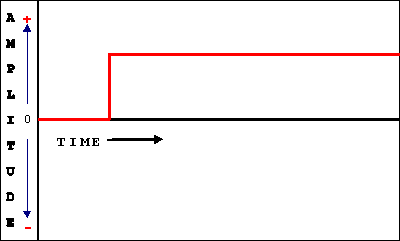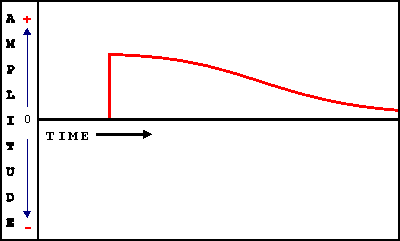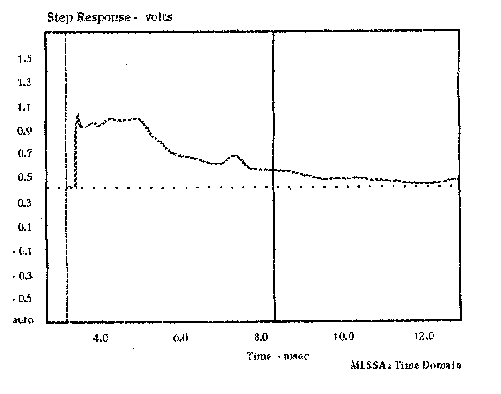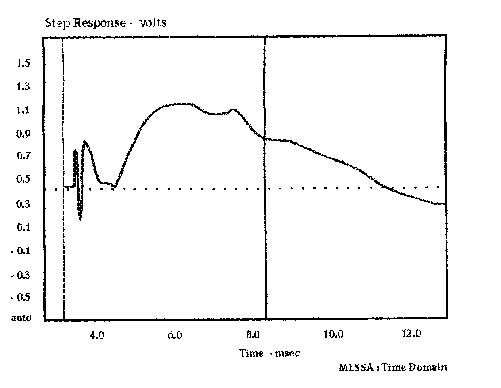![]()

STEP RESPONSE = THE TRUTH BE TOLD !
How do we reduce the question of time coherence to something that a consumer can compare?
Contents
Slanted Baffle Aligns
Acoustic Centers
Crossovers, aka Filters,
aka X/Os
Step Response -
The Truth Be Told
Other Troubles
With Complex Filters
In the lab, the nasty effect that phase shift has on waveform fidelity can be laid bare through the use of an elegantly simple test signal called a step response. This simple test asks a speaker to do all of the things that it will need to do to reproduce any musical waveform. Owing to its naked simplicity, all of a speaker's frequency, amplitude and timing errors are revealed at once. All but ignored by most consumers, and by the press - this is actually the single most important 'spec' that you should look at when comparing speakers.
Keep in mind that all that a speaker
can actually do is compress and rarefy the air around it; that is its ONLY job.
The step signal is a single, elegantly simple event - from a condition of rest, the speaker is asked to instantly compress the air, and that is all. In so doing the speaker readily reveals all that needs be known of its time domain behavior.
The figure below depicts this wonderfully simple waveform - you can see why it
is called a ‘step’.

Because the all speakers have low frequency limitations, the best that can be expected would be an acoustic output that looks something like this :

Here is the actual step response of our Heron.

Much to it's credit, Stereophile Magazine has actually been publishing this measurement in speaker reviews for the past few years. As far a s I know, these may be the only data available to consumers upon which to compare the time coherence of competing speaker designs.
Below it is the step response of a competitor’s design (you'll see many like this printed in Stereophile!).
Note the wild swings into rarefaction and the overall delayed energy
distribution. The speaker is 'sucking' when it should be 'blowing', and storing energy in the crossover, then releasing it later. Horrible stuff indeed...but very typical!!
Clearly, the output waveform bears absolutely no resemblance to the input waveform.
This typical, time incoherent speaker will certainly splatter the waveform of a horn or a violin or a voice in just the same, senseless manner.

Of course, the question that is being begged here is "Why would a speaker designer trash the time domain so?"
Well, mainly because they’re not paying much attention to it. Frankly, the steep filter crowd suffers from frequency/amplitude myopia. The current generation of PC based audio analyzers give a quick, easy view of the frequency domain - a one second test sequence put a frequency response plot up on the screen. It's easy to see how a man whose only tool is a hammer begins seeing every problem as a nail !
Also, complex filters allow great control over frequency response. Bumps and valleys can be patched with a dozen little ‘band-aids’, and marginal designs can thus be made to ‘work’.
Also, because the magazine spec game revolves around the spec of frequency response, designers generally tend to regard it at 'King of the Hill'.
Rarely do speakers with ‘smooth’ response curves take a beating from the press.
It is very easy to see how one might fall into thinking that frequency/amplitude is the whole enchilada. Besides, once one accepts a some time domain distortion, it’s pretty easy to accept a little more and a little more.
Too, customers are just not demanding time coherent products.
And, (here's the biggie) time incoherent speakers are a whole lot cheaper to make because you can get away with using much, much cheaper drivers and much, much cheaper cabinets.
In fact, many buyers are actually asking to be bamboozled: They'll take fancy veneer work and jewelry-store spikes on a third order design with and a vertical baffle !!!!
At Meadowlark Audio we come at the problem of speaker design from a unique perspective: we insist on correct time domain performance FIRST - there we give up nothing !!
Our speakers are designed in the time domain FIRST and, as it turns out, when a speaker's timing is correct, the frequency domain just plain lays down and falls into place. Just like magic, the whole design begins to work together to create music !